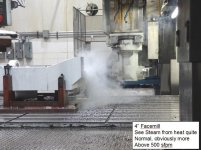Houndogforever
Hot Rolled
- Joined
- Oct 20, 2015
- Location
- Boring
I'm curious since I have a lot of time in this profession, but not a lot of variety.
If you are roughing, then finish milling after. How much stock do you leave to clean up on both radial and floor?
For Aluminum?
Radial = A
Floor = B
For carbon Steel
Radial = C
Floor = D
And why that amount?
My answers for carbide end mills are
A= .02
B= .01
C= .01
D= .03
I like a little more floor on the steel so that it hopefully gets a little more heat in the cut and doesn't tear the floor.
If you are roughing, then finish milling after. How much stock do you leave to clean up on both radial and floor?
For Aluminum?
Radial = A
Floor = B
For carbon Steel
Radial = C
Floor = D
And why that amount?
My answers for carbide end mills are
A= .02
B= .01
C= .01
D= .03
I like a little more floor on the steel so that it hopefully gets a little more heat in the cut and doesn't tear the floor.




